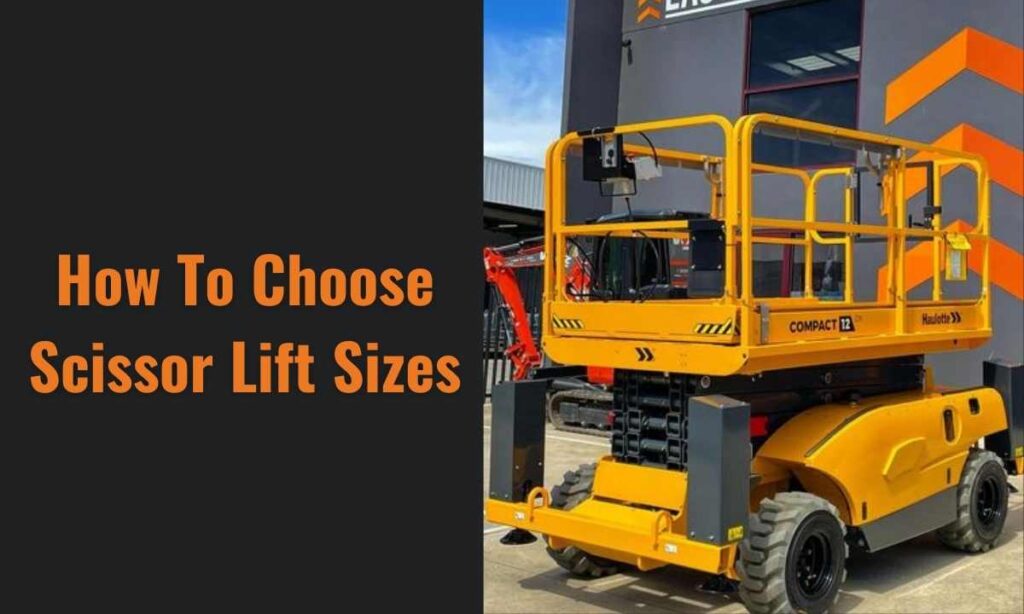How To Choose The Right Scissor Lift Size For Your Elevation Work
Table of Contents
The scissor lift is one of the most used aerial work platforms (AWP) used by access hire companies for accessing an elevated work location. These powerful, self-propelled vertical elevators simplify and make various jobs and circumstances safer. Scissor lifts can lift a platform to a maximum height of 2 feet and as high as 70 feet.
The height of a scissor lift is typically 20 to 40 feet. Scissor lifts are frequently preferred to scaffolding because they are safer but have a lower lifting capacity than other aerial lifts.
But how to choose the right scissor lift for your project?
Let us walk you through choosing the right scissor lift size you should use to save you from wasting time and effort in finishing your aerial project.
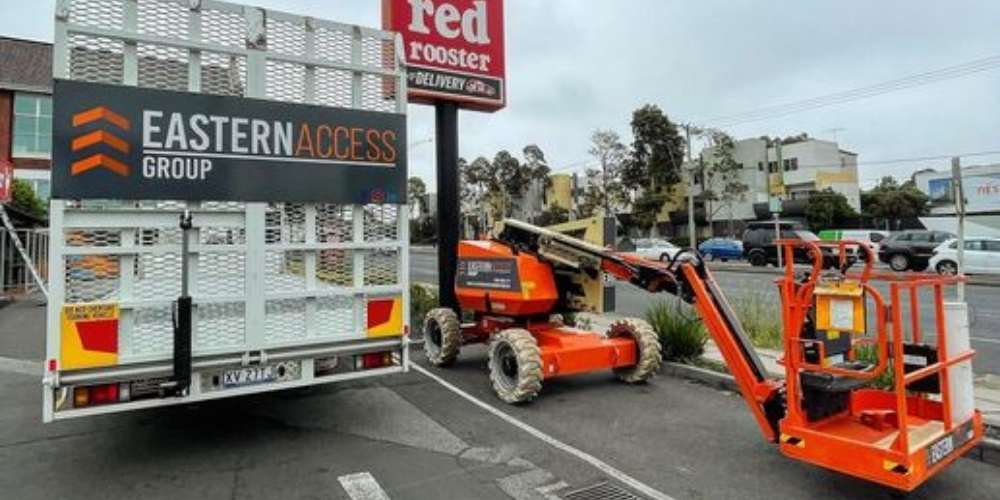
What is a Scissor Lift
A scissor lift is a type of machinery used to transport people and objects vertically. These lifts can do any task that ordinarily calls for a ladder, tower, or scaffolding. Without the setup time of conventional equipment, such as scaffolding or a building, and without the risky instability of a ladder, scissor lift operators may do the same tasks more quickly and safely.
While there is always a possibility of falling when working at any height, scissor lifts offer a safety harness or cable and a stable platform enclosed in a railing. For work of all kinds performed at low to medium elevations, the scissor lift’s work platform offers a sturdy base and unmatched safety.
Before renting a scissor lift, you should consider the height and lift a weight. These incredibly mobile aerial work platforms enable operators to move around awkward spaces and outdoor work sites.
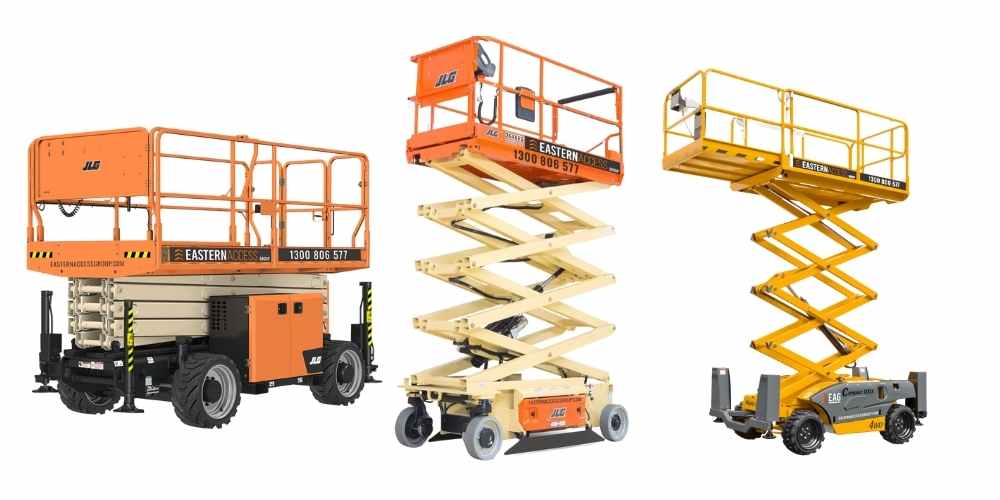
Types of Scissor Lifts
Hydraulic scissor lifts are used both indoors and outside. They are powered by an electric motor or compressed air. The hydraulic liquid is moved or drained from cylinder to cylinder, allowing the scissor lift to rise and fall as needed. Hydraulic scissor lifts are used in warehouses, construction sites, and infrastructure projects.
1. Hydraulic Scissor Lifts
Hydraulic scissor lifts can be used outside or indoors and are powered by an electric motor or compressed air.
The scissor lift is raised or lowered by pushing or draining hydraulic fluid from cylinder to cylinder.
For use on construction sites, infrastructure projects, and warehouses, hydraulic scissor lifts are advised.
2. Diesel Scissor Lifts
Traditional diesel engines are utilized to power diesel scissor lifts.
Because they are noisy and produce unclean exhaust gases when operating, they are less environmentally friendly than their electric equivalents.
Diesel scissor lifts are typically equipped with larger platforms. They are advised to be used on outdoor construction projects, in well-ventilated areas, and in locations where engine noise won’t distract or interfere with crucial employee communication.
3. Electric Scissor Lifts
Electric scissor lifts are better for the environment because they run on electric batteries rather than a combustion engine.
Because they don’t produce a lot of noise or exhaust pollutants when working, they are perfect for interior use.
Compared to their diesel-powered predecessors, electric scissor lifts are often lighter, more compact, and have smaller, narrower platforms.
Units are frequently equipped with non-marking tires because they work indoors, preventing floor damage.
4. Rough Terrain Scissor Lifts
Rough terrain scissor lifts are a specialized EWP that provides enhanced power for use in challenging outdoor conditions.
The necessary power to operate through rugged terrain and hoist higher cargoes are often powered by combustion diesel, petrol, or LPG engines.
Rough terrain forklifts offer increased traction and travel speed required to maneuver safely through significant construction sites.
5. Pneumatic Scissor Lifts
Because pneumatic scissor lifts are powered by air rather than electricity or hydraulics, they are exceedingly clean and require no maintenance.
They are perfect for businesses that prefer to operate sustainably and with a smaller carbon footprint because they raise and lower the lift using air pressure.
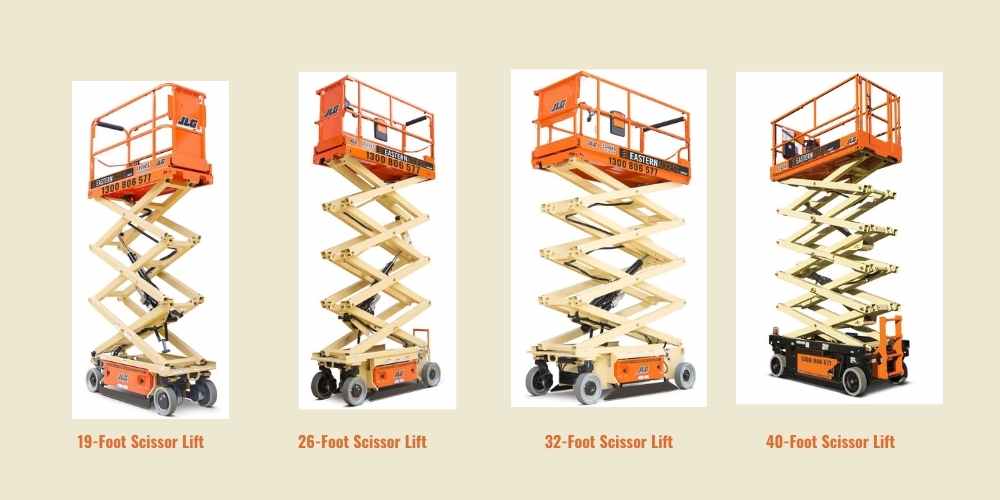
Scissor Lift Ranges
19-Foot Scissor Lift
This scissor lift is best suited for confined spaces and other interior workspaces because its small size makes it easy to use. This lift is electrically powered and doesn’t release hazardous fumes indoors. It can be utilized for upkeep and building projects inside.
26-Foot Scissor Lift
The 26-foot lift can handle tasks like pruning trees and hanging signs. It is a fantastic option for many industrial and construction projects since it offers a bigger work platform than a 19-foot lift and can hold more personnel and materials. For off-road and landscaping work, its four-wheel-drive architecture makes it suitable for challenging handling terrain, including slopes and inclines. To help you decide which machine you require, look up lift gradeability on the spec sheet.
The 26-foot lift is also available in an indoor or outdoor-use electric type with a narrow width.
32-Foot Scissor Lift
The 32-foot scissor lift is available in thin electric and four-wheel drive variants, just like the 26-foot lift. Use this lift for maintenance, construction, and industrial projects. The 32-foot lift provides workers with direct and secure vertical access to high work locations. It has interlocking bar-style struts for enhanced stability over an extended length of time.
40-Foot Scissor Lift
Three variations of the 40-foot scissor lift are available: a narrow electric model, a comprehensive electric model, and a four-wheel-drive type. Its design makes it suitable for working on outdoor industrial, construction, and maintenance applications since it enables numerous people to reach a high elevation.
The thin electric variant is ideal for high interior tasks like maintaining walls and ceilings. The broad electric variant can accommodate more people and is perfect indoors and outside for jobs like painting murals, laying masonry, installing roofs, and maintaining light fixtures.
50-Foot Scissor Lift
The 50-foot scissor lift is the best option for large jobs requiring the highest height. Its broader platform, which can hold many employees and hoist heavy items, and its four-wheel drive make it ideal for outdoor work.
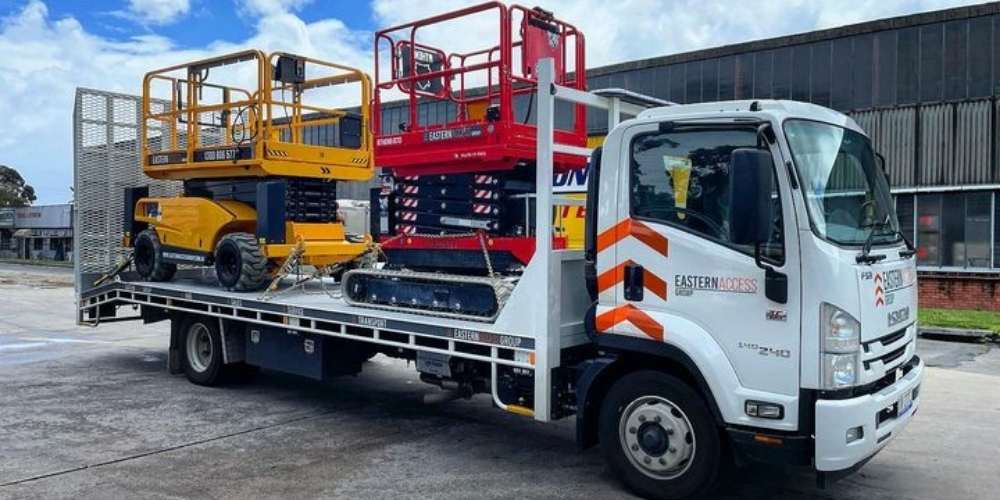
Factors To Consider When Choosing Scissor Lift
1.Environment Type
Think about the setting where you work. If you need to work indoors, you may need an emission-free electric lift. If you need to work outdoors, you may need a four-wheel-drive model. You may require a narrow lift to operate in active construction zones.
2. Capacity for Load
You must also consider any additional personnel you might require on the platform when determining how heavy cargo to raise. You are in need of a lift with an elevating work platform that provides a lot of space and the most stability if your task requires numerous workers or you need to carry more significant objects.
3. Type of Job You Need To Accomplish
What lift you choose depends on the specific duties needed for your project and the materials in your load. You could want a narrower or smaller charge if you maneuver through tight spaces. You may need a lift that goes higher if you need to fix something from above. Think about your load’s stability, the materials it contains, and the load’s centre of gravity. All of these factors impact your choice of lift.
4. Working Height
Make sure to consider the required minimum and maximum work heights for your job, which is the most obvious factor to consider. You should be able to select a scissor lift that gives you the proper amount of vertical reach, thanks to the range of heights available. If you come across multiple options that satisfy your height criteria, consider additional variables to reduce your chances further.
5. Width of the Platform
Platform size is an additional crucial factor to take into account. Platforms are available in typical sizes, but you can also extend the platform. But bigger doesn’t always equal better. The overall effectiveness of the lift is impacted when the platform size is increased since it shifts the lift’s centre of gravity. As an uneven load can lead to issues, make sure you adjust your lift calculations to consider the change.
Why Consider Using a Scissor Lift?
Because EWPs are meant for temporary employment, they usually require transportation between locations or merely around a single site. They are constructed for ease of movement and the ability to ride up and down ramps.
Access High Places and Tough to Reach Places
Scissor lifts give workers access to high places that would otherwise be inaccessible because they have lift heights up to 16 meters.
Workers can access previously difficult-to-reach regions to perform maintenance, repairs, or cleaning.
Easy to Operate
Scissor lift controls are straightforward, and operators may be trained quickly.
Flexibility Due to Small Size
The most portable kind of elevating work platform is a scissor lift. They can be used in confined locations with limited access because of their small size.
Number of Choices and Options
Thanks to the five basic types of scissor lifts covered in this blog, there is a choice for every application.
When selecting the ideal scissor lift for a particular application, the vast range of power plants, lift capacities and heights, various platform sizes, and safety features allow the utmost flexibility.
Lower Workplace Injury Rates
Scissor lifts provide a convenient and safe way to raise objects to the necessary height.
This significantly reduces worker injuries, notably back injuries from physical lifting.
The risk of stresses from lifting in the horizontal or vertical plane can be eliminated by raising the worker to the proper height so they can comfortably put away loads.
Additionally, scissor lifts might lessen the possibility of injuries among workers.
Key Takeaway
For many jobs, the best and safest way to access an elevated work area, scissor lifts, is a need. It’s not only about how high you need to lift things when selecting which scissor lift to hire. Anyone operating the scissor lift must know its controls, typical operations, and emergency procedures.
